Army "Isthmus". What are the armed forces of Central America
Recall that the countries of Central America include the Spanish-speaking Guatemala, Honduras, Costa Rica, Nicaragua, Panama and El Salvador and the English-speaking Belize. Among the seven countries in the region, Belize stands alone - in view of the fact that for a very long time it remained a British colony, and its political history developed in a completely different way than its Hispanic neighbors. As for the remaining six states of Central America, their political and military history and economic situation are very similar to each other, although there are a number of certain differences. Therefore, a review of the armed forces of the region makes sense to start with the army of Guatemala - the largest country in Central America. According to 2013 year, the population of Guatemala was 14 373 472 people, which made the country the largest population in the region.
Guatemala: from the militia to the regular army
The history of the armed forces of Guatemala has its roots in the era of the struggle for national independence of the countries of Central America against the Spanish colonialists. In the colonial era, the military units of the Spanish army stationed in the territory of the captaincy general of Guatemala, which existed in 1609 — 1821, were staffed either by settlers from Europe or their descendants. However, Captain-General Matias de Galves to protect the area from pirates, reinforced the colony's troops and began to recruit for service in military units of the mestizos. In the early years of independence, the army was a militia without real military training. The strengthening of the army was hampered by constant internal conflicts between individual commanders and the almost complete absence of military discipline.
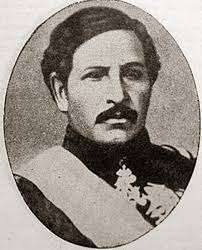 The first president of Guatemala, who attempted to modernize the country's armed forces, was General Rafael Carrera (1814-1865). It was this state and military leader of the country, who came from the Indians, officially declared independence of Guatemala back in 1839, completing the process of leaving the country from the united provinces of Central America. As president of 1844-1848 and 1851-1865, Carrera brilliantly repelled the attack of Honduras and El Salvador, who were seeking to restore the allied Central American state and even seized the capital of Salvador, San Salvador, in 1863 of Carrera, with the task of setting up a new Central American state, Carrera put X-rayre in the 1890 of Carrera to reinstate non-leaping power, in order to put it, it’s not a world to put it to put it to put it to put it to put it to put it to put it to put it to put it to put it to put it to put it to put it to put it to put it to put it to put it to put it to put it to put it!) I didn’t put it, I didn’t set myself to put myself in the 3 of Carrera. the forces of the region and for a certain period, as evidenced by its military successes, fully achieved this goal. In the subsequent period of the history of Guatemala, a gradual strengthening of the army took place, in which the opening of the Polytechnic School played a special role, where future officers began to undergo training. Thus, the foundation was laid for the formation of a personnel officer corps of the country. According to the Brockhaus and Efron Encyclopedic Dictionary, by 718, the Guatemalan armed forces consisted of a regular army of 67 300 soldiers and officers, and a reserve police of XNUMX XNUMX men. At the beginning of the twentieth century. In Guatemala, the Chilean military mission was established. More militarily developed, Chile assisted the Guatemalan government in modernizing the country's armed forces. By the way, Officer Ibáñez del Campo, who later became President of Chile, served in the mission.
The first president of Guatemala, who attempted to modernize the country's armed forces, was General Rafael Carrera (1814-1865). It was this state and military leader of the country, who came from the Indians, officially declared independence of Guatemala back in 1839, completing the process of leaving the country from the united provinces of Central America. As president of 1844-1848 and 1851-1865, Carrera brilliantly repelled the attack of Honduras and El Salvador, who were seeking to restore the allied Central American state and even seized the capital of Salvador, San Salvador, in 1863 of Carrera, with the task of setting up a new Central American state, Carrera put X-rayre in the 1890 of Carrera to reinstate non-leaping power, in order to put it, it’s not a world to put it to put it to put it to put it to put it to put it to put it to put it to put it to put it to put it to put it to put it to put it to put it to put it to put it to put it to put it to put it!) I didn’t put it, I didn’t set myself to put myself in the 3 of Carrera. the forces of the region and for a certain period, as evidenced by its military successes, fully achieved this goal. In the subsequent period of the history of Guatemala, a gradual strengthening of the army took place, in which the opening of the Polytechnic School played a special role, where future officers began to undergo training. Thus, the foundation was laid for the formation of a personnel officer corps of the country. According to the Brockhaus and Efron Encyclopedic Dictionary, by 718, the Guatemalan armed forces consisted of a regular army of 67 300 soldiers and officers, and a reserve police of XNUMX XNUMX men. At the beginning of the twentieth century. In Guatemala, the Chilean military mission was established. More militarily developed, Chile assisted the Guatemalan government in modernizing the country's armed forces. By the way, Officer Ibáñez del Campo, who later became President of Chile, served in the mission. Beginning with the 1930s, when General Jorge Ubiko-Castañeda (1878-1946) came to power in the country, the strengthening of the Guatemalan army began. In each province of the country, its political leader was at the same time a military commander, in whose subordination there was a company of regular infantry of about 100 soldiers and a company of reserve police. At the same time, in the 1930-ies, the cooperation of the Guatemalan army with the United States intensified, which was suspended after the coup of 1944, which overthrew the dictatorship of General Ubico and served as the basis for the country's patriotic reorientation. Nevertheless, the new revolutionary government tried to reorganize the Guatemalan army with its own forces — for example, the engineering battalion of the Guatemalan army, the country's first engineering unit, was created in 1946. In addition, the cavalry was eliminated as an independent branch of the military; 7 military districts and army headquarters were created. In 1949, the United States, due to further deterioration in US-Guatemalan relations, refused to supply Guatemala weapon. However, in 1951, the strength of the Guatemalan army was already 12 000 soldiers and officers, there were even their own air force with 30 old American aircraft. Before the start of the famous invasion by the CIA of the United States mercenaries in Guatemala, which occurred in 1954, the country's air forces included the 14 of old aircraft - 8 light attack aircraft, 4 transport aircraft and 2 training aircraft. By the way, a group of high-ranking Air Force officers, including Colonel Castillo Armas and even the Air Force commander Colonel Rudolfo Mendozo Asurdio, played an important role in organizing the invasion. The fact is that a significant part of the country's military elite never welcomed the revolutionary reforms of the government of President Jacobo Arbens and had close ties with the American special services, most often established during the training in military schools or cooperation with the US command. When, in Guatemala, as a result of the invasion, which had the official name of “Operation PBSUCCESS” (“Military Review” has already been written about it), the patriotic regime of President Jacobo Arbenz was overthrown, Colonel Castillo Armas, who led the invasion, came to power. He returned all the nationalized lands of the United Company to the United Fruit, abolished the progressive reforms of Arbenz and restored Guatemala’s military cooperation with the United States. April 18 A bilateral military-political agreement was concluded between the United States and Guatemala on April 1955. Since then, the Guatemalan army has played a crucial role in supporting the regimes of military dictatorships, repressions against dissidents, and the genocide of the Indian population of the country. However, not all military personnel of the Guatemalan army agreed with the country's military elite policy. So, on November 13, 1960, a famous uprising took place in the central barracks, organized by a group of junior officers of the Guatemalan army. The rebels managed to occupy a military base in Zacapa, but already on November 15, loyal parts of the government suppressed the attack. However, some of the participants in the uprising left the country or went underground. Subsequently, it was these junior officers of the Guatemalan army that created and led revolutionary communist guerrilla organizations that fought a long war against the central government. The most famous among them were Alejandro de Leon, Luis Augusto Turcios Lima and Mario Antonio Ion Sosa.
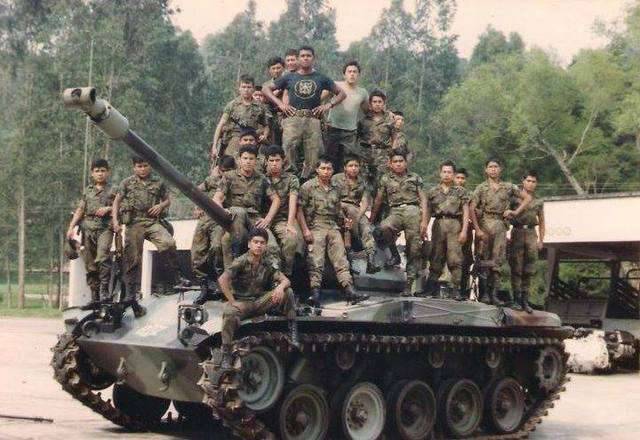
Throughout the 1960s and 1980s Guatemala continued to develop military-political cooperation with the United States. So, in 1962, the country became a member of the Central American Defense Council (CONDECA, Consejo de Defensa Centroamericana). In 1963-1964 over 40 U.S. military advisers and instructors arrived in Guatemala to supervise the training of Guatemalan units fighting the communist rebels. By 1968, the Guatemalan armed forces had 9 troops, including 000 serving in the ground forces, 7800 in the air forces and 1000 in the naval forces of the country. The training of Guatemalan officers at US military schools has begun. The army continued to grow in number - for example, in 200 the country's armed forces numbered 1975 thousand military personnel, as well as 11,4 national police officers. The ground forces, numbering 3000 thousand people, included six infantry and one parachute airborne battalions, the Air Force - 10 squadrons of assault, transport and training aircraft. The Guatemalan Navy had 4 small anti-submarine ship and several patrol boats. In addition, in December 1, special anti-partisan formations of special purpose — kaibili — were created, which in Mayan-quiche means “night tigers”. By 1975, due to the need to further increase the effectiveness of the anti-guerrilla war, the number of Guatemalan infantry battalions was increased to 1978, and the number of ground troops increased from 10 thousand to 10 thousand people. In 13,5, the number of ground forces increased to 1979 thousand people. The main focus in the 17s - 1970s. It was done specifically for the development of the ground forces, which, in fact, carried out the police functions of combating partisans and protecting public order. By the early 1980s in service with the army were 1990 tanks and 50 armored vehicles, and the strength of the armed forces was 28. In 000, after the cessation of the civil war in the country, over 1996 troops were dismissed from the army.
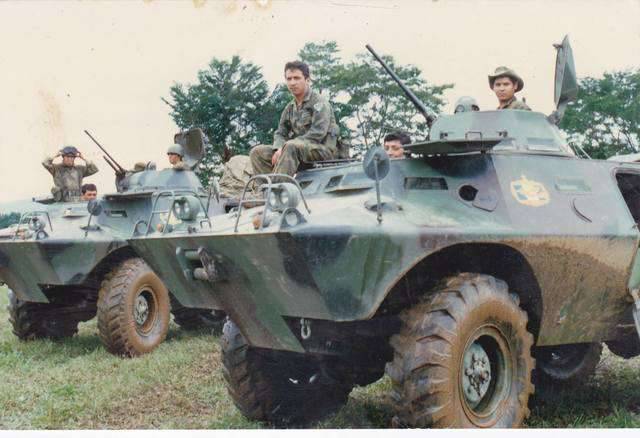
In 2010-2012 Guatemalan's armed forces numbered 15,2 thousand troops, another 19 thousand people served in the militia. In addition, about 64 thousand people were in reserve. The number of Guatemalan ground forces was 13 440 military. The ground forces included the 1 Special Operations Brigade, the 1 Reconnaissance Regiment, the 1 Presidential Guard Battalion, the 6 Armored Forces, the 2 Airborne Forces, the 5 Infantry, the 2 Engineering and the 1 Training Battalions. In service were 52 armored personnel carriers, 161 field artillery guns (including 76 units - 105-mm towed guns), 85 mortars, more 120 recoilless guns, 32 units. anti-aircraft installations M-55 and GAI-D01. The Guatemalan Air Force served 871 people, the Air Force had 9 combat aircraft, including X-NUMX attack aircraft A-2B and 37 light attack aircraft Pilatus PC-7, as well as 7 training and transport aircraft, 30 helicopters. 28 sailors and officers served in the Navy of the country, 897 patrol boats and 10 small river patrol boats were in service. Later, a reduction of the country's armed forces was carried out. The structure of the armed forces of Guatemala is currently as follows. It is headed by the Commander-in-Chief of the Guatemalan army, who exercises leadership through the Minister of National Defense, to whom the Deputy Ministers of Defense are subordinate. The leadership of the land forces of the country is carried out by the inspector general of the army and the army headquarters.
The armed forces of Guatemala have established the military ranks characteristic of many Spanish-speaking states: 1) a division general (admiral), 2) a brigadier general (vice admiral), 3) colonel (captain fleet), 4) lieutenant colonel (captain of the frigate), 5) major (captain of the corvette), 6) prime captain (lieutenant of the fleet), 7) second captain (lieutenant of the frigate), 8) lieutenant (alperes of the fleet), 9) sub-lieutenant ( alferes corvette), 10) sergeant major (master major), 11) technician sergeant (master technician), 12) first sergeant (master), 13) second sergeant (counter-master), 14) corporal (first sailor ), 15) a soldier of the first class (second sailor), 16) a soldier of the second class (third sailor). As you can see, the title "Alperes", which in many Spanish-speaking armies is the youngest officer rank, is retained only in the Navy in Guatemala. Guatemalan officers are trained at the Polytechnic College, which is the country's oldest military educational institution with more than a century of history. College graduates are awarded a bachelor's degree in technology and resource management and a military rank of lieutenant. Guatemalan army reserve officers are trained at the Adolfo V. Hall Institute, which provides training for Guatemalan university students on the basics of military knowledge. Graduates of the institute receive the rank of lieutenant of the reserve of the ground forces and a bachelor's degree in arts and sciences or sciences and literature. The institute, founded in 1955, got its name in honor of Sergeant Adolfo Venancio Hall Ramirez - the hero of the Battle of Chalchuap. The training of the country's air force officers is carried out at the military aviation school.
Guatemalan "night tigers"
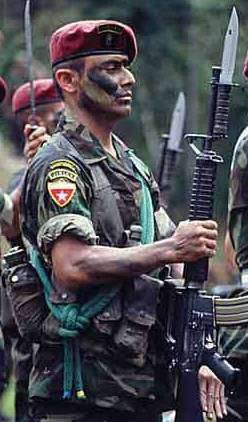 The most combat-ready and elite unit of the Guatemalan army continues to be the legendary "Qaibili" - the special team "Night Tigers", founded in 1975. It is used for special operations, reconnaissance, and counter-terrorism. At the request of the UN, 2 companies of "night tigers" participated in peacemaking companies in Liberia, Congo, Haiti, Nepal, Cote d-Yvoire. Back in 1974, the Guatemalan Training and Special Operations Center was established, in which the commandos should be trained to participate in the fight against the communist partisans. In 1975, the center changed its name to Caibil School, to which instructors from among American Rangers were sent to improve the training system. In 1996, after the termination of the civil war in the country, the President of Guatemala, Alvaro Arzu Irigoyen, announced his decision to retain “caibili”, but in a new capacity, as special units to fight drug trafficking, terrorism and organized crime. American military instructors continued to train the Qaibili. Foreign military experts have called “cabili” “terrible murder machines,” because of the brutal training and tactics used. This name fully reflects the essence of the special forces, which until now does not hesitate to show inadmissible cruelty to many civilians in relation to the civilian population during special operations. It is also known that many former special forces "Qaibili", demobilized from the armed forces, do not find themselves in a "civilian" poor Guatemala and prefer to enter the service of the drug mafia, which uses them as bodyguards of their bosses or killers to eliminate competitors.
The most combat-ready and elite unit of the Guatemalan army continues to be the legendary "Qaibili" - the special team "Night Tigers", founded in 1975. It is used for special operations, reconnaissance, and counter-terrorism. At the request of the UN, 2 companies of "night tigers" participated in peacemaking companies in Liberia, Congo, Haiti, Nepal, Cote d-Yvoire. Back in 1974, the Guatemalan Training and Special Operations Center was established, in which the commandos should be trained to participate in the fight against the communist partisans. In 1975, the center changed its name to Caibil School, to which instructors from among American Rangers were sent to improve the training system. In 1996, after the termination of the civil war in the country, the President of Guatemala, Alvaro Arzu Irigoyen, announced his decision to retain “caibili”, but in a new capacity, as special units to fight drug trafficking, terrorism and organized crime. American military instructors continued to train the Qaibili. Foreign military experts have called “cabili” “terrible murder machines,” because of the brutal training and tactics used. This name fully reflects the essence of the special forces, which until now does not hesitate to show inadmissible cruelty to many civilians in relation to the civilian population during special operations. It is also known that many former special forces "Qaibili", demobilized from the armed forces, do not find themselves in a "civilian" poor Guatemala and prefer to enter the service of the drug mafia, which uses them as bodyguards of their bosses or killers to eliminate competitors. Salvadoran army
El Salvador is one of Guatemala’s closest neighbors. It is the most densely populated country in Central America: more than 21 million people live on the area of 6,5 thousand km. Almost the absolute majority (over 86%) of the country's population are mestizos, the second largest are white Creoles and Europeans, and the Indian population is extremely small (about 1%). In 1840, Salvador became the last state to emerge from the Central American Federation (United Provinces of Central America), after which this political entity ceased to exist. Since the departure of El Salvador from the United Provinces, the history of the armed forces of this small country began. Initially, the armed forces of El Salvador consisted of several units of light cavalry, performing both military and police functions. By 1850. The country's army has increased significantly in number, dragoon squadrons, infantry units and artillery were created. K 1850-1860-m. the officer corps of the Salvadoran army, originally consisting almost entirely of Creoles of European origin, is also taking shape. In order to reform the Salvadoran army in the country, the French military mission was opened, with the help of which an officer school was soon established, which was later transformed into the Military Academy of El Salvador. The development of military science and weapons demanded the opening of the early 1890-ies. and the School of sub-officers, in which the training of non-commissioned officers of the Salvadoran army was carried out. Military instructors began to be invited not only from France, but also from the USA, Germany and Chile. By 1911, the army of El Salvador was completed by conscription. In parallel, the improvement of the system of recruitment and training of the Salvadoran army was carried out and the strengthening of its internal structure. Thus, in 1917, a cavalry regiment was established, stationed in the capital, San Salvador. The Washington Conference was held in 1923, at which representatives of the countries of Central America signed the “Peace and Friendship Treaty” with the USA and the “Arms Reduction Convention”. In accordance with this convention, the maximum strength of the armed forces of El Salvador - 4200 troops (for Guatemala, as a larger country, the threshold number was set in 5400 troops). 1901 to 1957 the organization of training and education for the Salvadoran army was engaged, as in neighboring Guatemala, the military mission of Chile.
Military cooperation with the United States began later than with Chile - in the 1930-ies, and reached its highest levels already during the Cold War. It was then that the United States was seriously concerned about preventing the spread of communist ideology in Central America. To organize opposition to the possible deployment of the insurgency in the region, the United States took control of all matters of financing, armament, training, organizing the management of the Central American armies. However, until the beginning of the 1950's. Salvador did not have a large army. Thus, in 1953, the number of armed forces in the country was 3000 people, and only in the event of war and mobilization was it possible to deploy 15 infantry, 1 cavalry and 1 artillery regiments. As in neighboring Guatemala, the army played a large role in the political history of El Salvador. In 1959, the military dictator of El Salvador, Colonel José Garcia Lemus, and the dictator of Guatemala, Idigoras Fuentes, signed an “anti-communist pact” that provided for the cooperation of the two countries in the fight against the communist threat in Central America. In 1962, El Salvador became a member of the Central American Defense Council (CONDECA, Consejo de Defensa Centroamericana). At the same time, the country's military cooperation with the USA also grew. In July 1969, there was a short-term military conflict between El Salvador and its closest neighbor Honduras - the famous “Football War”, which formally caused riots in both countries in connection with the struggle of the football teams of Honduras and El Salvador to qualify for the final part of the World Cup 1970 of the year. In fact, of course, the conflict had other reasons - El Salvador was the largest creditor of economically weaker Honduras, the sparsely populated El Salvador attracted the lands of a larger, territorially and less populated neighbor. 24 June 1969, El Salvador began mobilizing the armed forces. 14 July 1969. Five infantry battalions of the Salvadoran army and nine companies of the National Guard invaded Honduras, at the same time the Salvadoran air forces began striking the country's most important strategic points. The war lasted 6 days and cost 700 to Salvador and 1200 to Honduras. To strengthen the defense of El Salvador, the war was also important because it led to an increase in the number of armies. Already in 1974, the armed forces of El Salvador numbered 4,5 thousands of people in the ground forces, 1 thousand more people served in the air force and 200 people in the naval forces.
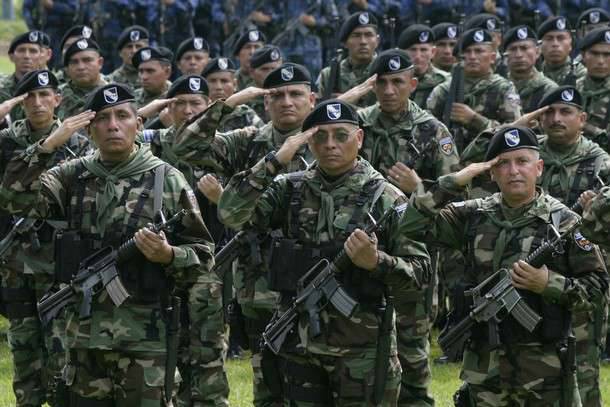
Civil war and the growth of the Salvadoran army
The internal political situation in the country gradually deteriorated. Economic problems caused a political crisis and a series of military riots and clashes. Rebel organizations of the left radical type were formed. October 11 The Farabundo Martí National Front for National Liberation was created on 1980 and consisted of: the Farabundo Martí People’s Liberation Force (FPL) with its own armed unit “The People’s Liberation Army”, the Revolutionary Party of El Salvador with its own armed unit “The Revolutionary Army of the People” , National Resistance (RN) with its own armed formation “Armed Forces of National Resistance”, the Communist Party of El Salvador (PCS) with its own armed formation Development of the Armed Forces of the Liberation, Revolutionary Party of Workers of Central America (PRTC) with its own armed formation, the Central American Revolutionary Army of Working People. The outbreak of civil war and demanded the strengthening of the Salvadoran government army. It was 1978 The armed forces consisted of 7000 military personnel and 3000 officers of other paramilitary units. The ground forces consisted of three infantry brigades, 1 cavalry squadron, 1 parachute company, 2 commando companies, 1 artillery brigade and 1 anti-aircraft division. The air force had 40 aircraft, Navy 4 patrol boats. Already in 1979 An increase in the number of armed forces began, and at the same time the United States began to provide serious military assistance to the Salvadoran army. Initially, Salvadoran officers were sent for retraining to the American military camps in Panama, as well as in the "School of the Americas" in Fort Gulik in the United States. With 1981 1985 for years. the number of armed forces of El Salvador increased to 57 thousand soldiers, the number of police - to 6 thousand. people, fighters of the National Guard - up to 4,2 thousand. people, rural and customs police - up to 2,4 thousand human. The combat capability of army and police units also increased. Five airmobile rapid-response battalions of 600 soldiers were formed in each - Atlakatl, Atonal, Arce, Ramon Belloso and General Eusebio Brasamonte. They were directly subordinate to the general staff of the Salvadoran armed forces and were used in the fight against the partisans. Also paratroop battalion, 20 battalions of light infantry "Kazador" ("Hunter") on 350 soldiers and officers in each belonged to combat-ready units of the army. For each army brigade a company of long-range intelligence was assigned, another company of long-range intelligence was formed as part of the Air Force of El Salvador. In 1985 was In the country's Navy, a Marine battalion of “12 October” with up to 600 military personnel was established. Also part of the Navy in 1982. A long-distance reconnaissance company was formed, transformed into a battalion of "marine commandos", consisting of a company of the protection of a naval base, a company of commandos "Piranha", a company of commandos "Barracuda", a group of combat swimmers. A company of anti-terrorist operations in cities and rural areas was included in the National Guard.
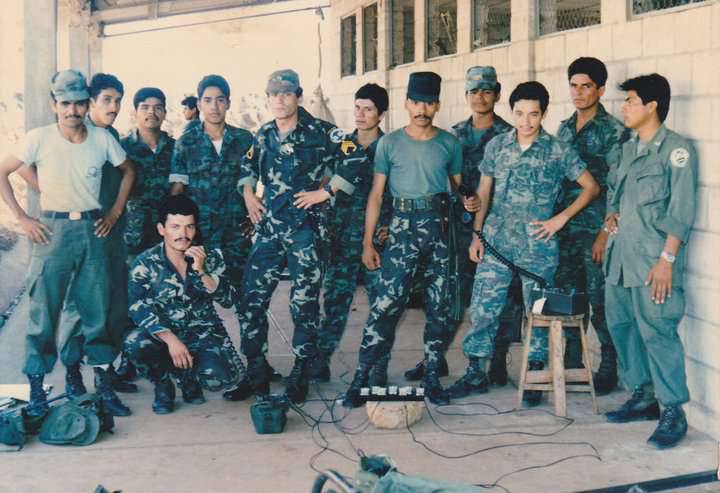
National Guard and Death Squadrons
An important role in the civil war in El Salvador was played by the National Guard. This structure, similar to the gendarmerie of many countries, existed 80 years - from 1912 to 1992 years. It was created in 1912 for the protection of public order and the fight against crime in rural areas, the protection of coffee plantations, but almost throughout its history, the most important task of the National Guard remained the suppression of numerous popular demonstrations. From 1914, the National Guard was part of the armed forces, but was administratively subordinate to the Ministry of the Interior of El Salvador. When creating the National Guard, the structure of the Spanish Civil Guard was taken as a model. The size of the National Guard was determined in the 14 company - one company in each department of El Salvador. In the event of the outbreak of hostilities, five battalions of the National Guard were formed as a result of the information of companies. It is noteworthy that even the Communists responded with great respect about the first years of the existence of the National Guard of El Salvador - after all, at that time, the national guards, at the cost of enormous losses, were fighting the rampant gangsterism in the countryside of El Salvador. But already by 1920. The National Guard actually turned into a repressive apparatus. By the time the civil war began, the number of national guards was about 3000 people, later it was increased to 4 thousand people, and then, by 1989 year, to 7,7 thousand people. In addition to the usual territorial units, the National Guard consisted of: the September 15 battalion, which served to guard the Pan-American Highway and consisted first of 218, and then 500 of military personnel; a company for anti-terrorist operations in cities and rural areas; Presidential battalion. Also, the National Guard included the Special Investigation Service, its own political intelligence and counterintelligence unit.
The civil war in El Salvador continued from 1979 to 1992. and cost the country 75 thousands of dead, 12 thousand. missing and over 1 million of refugees. Should we say that the economic damage caused by the civil war in a tiny country was enormous. In addition, cases of transition of individual soldiers and even entire units to the side of partisan formations have repeatedly occurred. Even the senior officer of the Salvadoran army, Lieutenant-Colonel Bruno Navaretta, and his subordinates, went over to the insurgents, who on the radio of the rebel organization appealed to the armed forces personnel to follow his example and support the armed struggle against the ruling regime. On the other hand, anti-communist forces with money from the United States and local oligarchs formed death squads, the most famous of which was the Guatemalan-Salvadoran Secret Anti-Communist Army. The immediate organizer of the death squads was Major Roberto d'Aubusson (1944-1992), who began serving in the National Guard and then became an intelligence officer of the general staff of the armed forces. Former extreme anti-communist, Aubusson back in 1975. founded the right-wing radical organization "Union of the White Warriors", and in 1977 co-founded (from the Salvadoran side) the Secret Anti-Communist Army. The CAA has begun to commit terrorist acts against the Salvadoran left-wing forces, as well as the country's political figures, which, according to right-wing circles in the army and the police, were a threat to the existing order. Back in the city 1981 US President Ronald Reagan proclaimed El Salvador "battlefield with international communism," after which the United States began to provide enormous financial support to the Salvadoran government, estimated at billions of dollars. As is quite understandable, the bulk of these funds were used to strengthen, train and equip the armed forces, the National Guard and the police forces of El Salvador, and also to maintain non-governmental anti-communist armed groups. In each of the six army brigades of the Salvadoran ground forces there were three US military advisers, and 30 CIA officers were sent to strengthen the El Salvador Security Agency. In total, about 5 thousands of US citizens participated in the civil war in the territory of El Salvador - both as military advisers and as instructors, specialists, civilian personnel (propagandists, engineers, etc.). Thanks to strong US support, leftist forces failed, unlike neighboring Nicaragua, to win the civil war in El Salvador. Only in 1992, after the end of the civil war, did the gradual reduction of the armed forces of El Salvador begin. Initially, they were cut from 63 thousand. to 32 thousand man, then, to 1999 year - up to 17 th. human. 15 thousand of them people served in the Army, 1,6 th. man - in the Air Force, 1,1 th. man - in the navy. In addition, 12 thousand. man remained in the Salvadoran police. The National Guard of El Salvador was disbanded in 1992, and a special military security brigade was created instead. After a general reduction in the armed forces, the number of Salvadoran marines was also reduced. The naval battalion "October 12" was reduced to 90 people. Currently, it is a division of special-purpose landing forces used for fighting in coastal waters, fighting crime, and supporting the population in emergency situations.
The current state of the Salvadoran army
Currently, the strength of the armed forces of El Salvador has increased again - up to 32 people. The command of the armed forces is carried out by the President of the country through the Ministry of National Defense. The direct command of the armed forces is carried out by the State Joint Headquarters of the Armed Forces, which includes the chiefs of staff of the land forces, air force and naval forces of the country. The recruitment of the rank and file of the country's armed forces is carried out at the call of males who have reached the age of 000, for a period of 18 year of service. Officers are trained in the military educational institutions of the country - the military school "Captain General Gerardo Barrios", the military aviation school "Captain Reinaldo Cortes Guillermo". Graduates of military schools are awarded the rank of lieutenant or equivalent ranks of the Air Force and Navy. In the armed forces of El Salvador, ranks have been established that differ in the ground forces, air force and naval forces. The following ranks have been established in the ground forces: 1) divisional general, 1) brigadier general, 2) colonel, 3) lieutenant colonel, 4) major, 5) captain, 6) lieutenant, 7) sublieutenant, 8) brigade sergeant major, 9) first sergeant major, 10) sergeant major, 11) first sergeant, 12) sergeant, 13) subsergeant 14) corporal, 15) private. In the Air Force, there is a hierarchy of ranks similar to that of the Army, with the only exception that instead of a divisional general in the Air Force, there is a rank of "general aviation". The Salvador’s naval forces have their own ranks: 1) vice admiral, 2) rear admiral, 3) captain of the fleet, 4) captain of the frigate, 5) captain of the corvette, 6) lieutenant of the fleet, 7) lieutenant of the frigate, 8) lieutenant corvette, 9) master major, 10) first master, 11) master, 12) first sergeant master, 13) sergeant master, 14) sub-sergeant master, 15) corporal master. Military ranks are the personal property of Salvadoran officers, which remains after dismissal from the army - only a court sentence can deprive an officer of a military rank even after resignation. The armed forces of El Salvador take part in numerous military Olympiads taking place in the countries of Central and South America, and Salvadoran special forces demonstrate very high combat training at competitions.
Currently, the army of El Salvador is increasingly being used to combat drug trafficking and youth gangs, rampant in the country's cities. The extremely high level of crime in the country, due to the low standard of living of the population, does not allow to fight crime only by police forces. Therefore, the army and attracted to patrol Salvadoran cities. The main adversary of the Salvadoran military in the slums of the country's cities are the members of Mara Salvatruch (MS-13), the country's largest mafia organization, numbering up to 300 of thousands of people according to some media. Almost every young man in the slums of Salvadoran cities to one degree or another is associated with the mafia group. This explains the extreme toughness with which the Salvadoran military operate in slum settlements. In addition, units of the Salvadoran army took part in a number of UN peacekeeping operations in Liberia, Western Sahara, and Lebanon. In 2003-2009 contingent of the Salvadoran army was in Iraq. With personnel rotations in Iraq, 3400 Salvadoran troops served, 5 people died. In addition, Salvadoran military personnel took part in the hostilities in Afghanistan. With regard to military assistance from foreign countries, in 2006, the Salvadoran leadership turned to Israel for help - the command of the Salvadoran army was counting on the help of the IDF in training programs for officers and training of reservists. The most significant military aid to El Salvador continues to be provided by the USA. It is the United States that is currently financing educational programs for the Salvadoran army, providing weapons from small arms to armored vehicles and helicopters.
To be continued ...
- P P 'SЊSЏ RџRѕR "RѕRЅSЃRєRёR№
- http://hemisferiozero.com/, http://ordendebatallainternacional.blogspot.ru/,
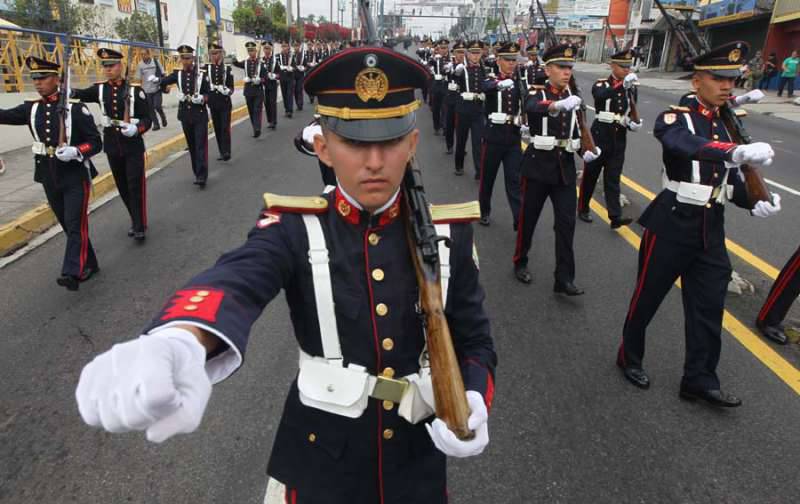
Information